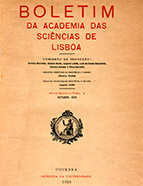

................................
165-184) and Os portugueses na cartografia antiga da África Central [The Portuguese in Early Cartography of Central Africa] (1550-1800)” (January-February 1963, pp. 13-27). Similarly, Armando Cortesão and Jacinto do Prado Coelho made notable contributions with Cartografia portuguesa e a Geografia de Ptolomeu [Portuguese Cartography and the Geography of Ptolemy] (intended for inclusion in their História da Cartografia Portuguesa [History of Portuguese Cartography]) and a report on the IV International Congress of Comparative Literature (October-December 1964, pp. 388-404 and 470-482), respectively. The Boletim also includes analyses of specific historical moments in the ACL’s history, such as texts on the Duke of Saldanha’s membership career (November 1949, pp. 346-347) and on honorary members like Garção Stockler, the Count of Ega, and Andoche Junot (October-December 1964, pp. 518-520; see José Alberto Silva, A Academia Real das Ciências (1779-1834)… Op. Cit. , pp. 85-86). Of particular note is the valuable series of portraits of presidents, vice-presidents, and other leaders of the institution since its founding, featured in several issues from 1958 and 1959. There are dozens of such examples.
After the 25 April 1974, the ACL appeared more open to engaging with the political issues of the time. (It had previously published a text on the invasion of Goa in 1963, pp. 381-384.) On 27 January 1975, Léopold Senghor, the President of Senegal, was received and delivered a lecture on Lusitanidade e Negritude [ Lusitanity and Blackness] in the presence of the President of the Republic, Costa Gomes, the Prime Minister, Vasco Gonçalves, and the Cardinal Patriarch of Lisbon, António Ribeiro. Senghor was admitted as a corresponding member that same day (1975, pp. 39-46 and 50-51). With the advent of the new political regime, the Academy’s doors opened to prominent figures in national literature, theatre, academia, and culture, many of whom had been critics or opponents of the Estado Novo . These included Luiz Francisco Rebello, José-Augusto França, Urbano Tavares Rodrigues, Vasco Magalhães-Vilhena, Maria Helena da Rocha Pereira, José Rodrigues Miguéis, Joel Serrão , and Orlando Ribeiro— esteemed individuals unjustly excluded from the Academy until then (1975, pp. 78-79, 136-138, 215-216, and 224-226; 1976, pp. 16-17, 67-69, and 97-101). Regrettably, their inclusion in the Academy coincided with a period when the publication of the Boletim had been reduced to its minimal form. Speeches were summarised, sometimes reduced to a single paragraph, as in the cases of Maria Helena da Rocha Pereira on Pedro Hispano, Luiz Francisco Rebello on Teixeira de Pascoaes , and Urbano Tavares Rodrigues on Alves Redol (1976, pp. 123-124 and 1977, pp. 179 and 198). In this way, intellectuals and academics appear to coexist more harmoniously within a democratic framework, with distinguished careers and works no longer constrained by prior censorship or oaths of allegiance to the Estado Novo . A form of reconciliation seems to have occurred between the old Academy and the established intelligentsia— a symbiosis that endures to this day. A comparable process, albeit without indulging in undue anachronisms, took place with the statutory reform of 1851-1852. This reform brought figures like Alexandre Herculano and his contemporaries into the ACL, paving the way for the establishment of the Curso Superior de Letras [Higher Education Course of Arts and Humanities] nearly a decade later, the precursor to the Faculty of Arts and Humanities at the University of Lisbon.
This work is financed by national funds through FCT - Foundation for Science and Technology, I.P, in the scope of the projects UIDB/04311/2020 and UIDP/04311/2020.
